
Spaceflight Now +

|

|
 |
 |

Subscribe to Spaceflight Now Plus for access to our extensive video collections!
 How do I sign up? How do I sign up?
 Video archive Video archive

STS-120 day 2 highlights

Flight Day 2 of Discovery's mission focused on heat shield inspections. This movie shows the day's highlights.

 Play Play

STS-120 day 1 highlights

The highlights from shuttle Discovery's launch day are packaged into this movie.

 Play Play

STS-118: Highlights

The STS-118 crew, including Barbara Morgan, narrates its mission highlights film and answers questions in this post-flight presentation.

 Full presentation Full presentation
 Mission film Mission film

STS-120: Rollout to pad

Space shuttle Discovery rolls out of the Vehicle Assembly Building and travels to launch pad 39A for its STS-120 mission.

 Play Play

Dawn leaves Earth

NASA's Dawn space probe launches aboard a Delta 2-Heavy rocket from Cape Canaveral to explore two worlds in the asteroid belt.

 Full coverage Full coverage

Dawn: Launch preview

These briefings preview the launch and science objectives of NASA's Dawn asteroid orbiter.

 Launch | Science Launch | Science

 Become a subscriber Become a subscriber
 More video More video

|
 |
 |

|
|
 |

Peter Jenniskens:
Meteorite hunter extraordinaire
By DR EMILY BALDWIN
Posted: 11 May, 2009
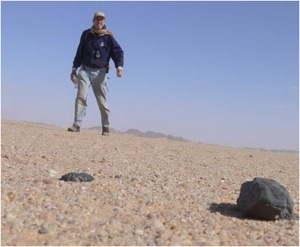
Peter Jenniskens led an expedition into the Nubian desert to recover hundreds of fragments from asteroid 2008 TC3 that exploded over the skies of Sudan last October. To read the full story of 2008 TC3, be sure to pick up a copy of the June issue of Astronomy Now, onsale 21 May.
What made you confident that you would be able to recover fragments from such a high altitude explosion?
I wasn’t confident at all! It was just that if something could be collected it would very clearly be very important science. My first trip to Khartoum at the beginning of December I really went with the expectation that the trip would be a success if I just got the chance to talk to some of the eye witnesses in the area and discuss with the researchers of the university whether it might be possible to organise a trip. But instead, my contact Mauwia Shaddad (Physics department, University of Khartoum), was a really good organiser so when I arrived I gave a talk at the university and then shortly after that we travelled north and talked to eye witnesses at station 6, the area where the meteorites fell. Then we travelled on to the border with Egypt and we took star background images from the same place as the observers had taken their images, so I could choose nearby reference marks and so on to position myself at the exact same spot and take a picture of star background so I know what the altitude and azimuth was in the field.
Talking to eye witnesses made it clear that no one saw things come out of the explosion and made the chance to find something a little pessimistic.
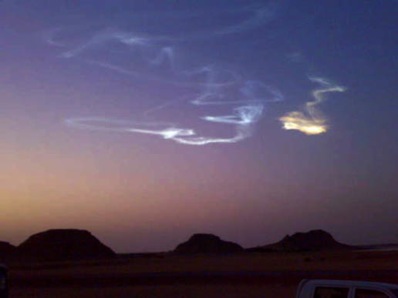
Image taken by a cellphone of the contrail left by 2008 TC3 during its decent. Image: Shaddadd.
But by that time Mauwia had brought a bus full of 45 students and staff and so we gave it a chance. So on the third day we created our own road by driving two cars 28 kilometres into the desert by marking off the area on our GPS in a straight line out. And then we went back to station 6 and the bus was loaded and the bus went out along that road to the beginning point. I had chosen the area to search a little bit down from the explosion with the idea that if nothing big came out of the explosion then we might want to search for smaller pieces. Smaller pieces tend to be quickly slowed down by the atmosphere and they tend to fall closer while the bigger pieces keep going with the original speed downrange. In the end we discovered that between where we found the first piece and final piece was 29 kilometres.
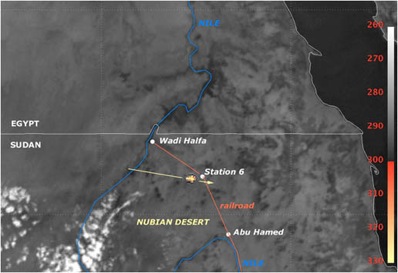
Infrared image taken by the Meteosat 8 satellite of asteroid 2008 TC3 exploding. Image: EUMESTAT.
What basically happened was there was a big explosion high in the atmosphere that turned the asteroid into dust, 80,000 kilograms came in, and in the end we think we recovered 5 kilograms, a tiny fraction. And the material that came from the explosion came out at such a high speed and still pretty much unstopped by the atmosphere at this point, it was still moving at its original speed - 12.4 kilometres per second - and as a result the pieces are spread out so far. So if this happened deeper into the atmosphere the asteroid is slowed down and the explosion is much less violent and the pieces are much less spread out because they come out of the explosion slower. So normally these strewn fields are a lot smaller, but in this case they were extremely spread out and if we didn't have a bus of students we would never have found the meteorites. I myself walked out on the 3 days and didn't find a single meteorite. We were 45 people and only 15 people found meteorites. Once we had everyone lined up we started walking, it took the group 2 hours to find the first meteorite, by a student called Mohamand Alamean, who was very dedicated and efficient.
How many more trips have been made into the desert?
The university made one more trip shortly after the first one (I couldn’t get a visa in time and everyone wanted to come now) and most of the efforts were spent trying to find larger pieces further downrange. But it turned out there were no large pieces -the biggest ones are hand palm sized. On the last day of the search a lot of the larger pieces were found just out of the search path, so initially we focused on the area slightly north, and now we searched slightly south and found a number there and the question came up: is the strewn field very wide? And so we when back with 52 people and that time we did vertical scans, measured how wide the field was spread out - we had 280 meteorites from an area 28 kilometres long and 8-9 kilometres wide, a huge area to search. But they stood out from the background rock which was angular in shape because these rocks were really much darker and rounder - pebbly looking. The smallest ones were a few centimetres, going up to 10 centimetres.
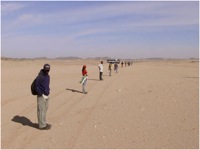
The meteorites are very porous. Presumably the asteroid was compressed as it traversed the atmosphere, does that mean the asteroid was even more porous?
The asteroid was more porous. If you calculate what the tensile stress was it was one Mega Pascals, very low, which means that the asteroid as a whole hangs very loosely together. We think it was a chip off a block, not a rubble pile, that is, the asteroid in the past was certainly part of a larger asteroid. It was very dark and porous for this type of meteorite. But because we were able to recover something that exploded so high up in the atmosphere on the conditions that normally would not have allowed a recovery, we could find something unique.
If the asteroid had been stronger would you have been able to recover more or less meteorites?
If it was denser it would have penetrated deeper into the atmosphere, which is a more classical way, and makes it easier to recover meteorites, but maybe it would not have been so unique. Basically we found a material that was not in our meteorite collection and we were able to make a direct link with an asteroid, which is really interesting.
 What do the textures in the meteorites tell you about the processes that have taken place on the asteroid? What do the textures in the meteorites tell you about the processes that have taken place on the asteroid?
In our Nature paper we kept a little bit back about that as this was not really the purpose of this paper. All the studies that we did so far was to establish the link between the meteorite and asteroid, look at the reflection properties and see how they compare, and determine the type of meteorites they are giving. But we are hoping that the fact this is an anomalous material for this type of ureilite that it will help explain the properties of ureilites. An interesting aspect is that not all the meteorites are the same, there is quite a variety of materials found - one or two are very fine grained or light grained in texture and other meteorites are very dark and black and scruffy, and so this particular asteroid had a wide range of materials in it. So to answer your question we need to study all these different materials and then put this whole picture in context, but this is definitely going to help make a distinction between all the ideas about ureilites as there are many different ideas on how these different meteorites were formed. These meteorites are very special in the sense they are right in between the primitive chondrites and the non-primitive achondrites. The chondrites are still composed of the original materials that came together like little droplets and dust specks. The achondrites typically come from differentiated asteroids where the whole asteroid got molten and the iron sank to the core and lighter stuff floated on top. This ureilite is material that is partially molten. So some of the minerals were so hot and some got molten, but most didn't. So was this heating a deep magma event inside the interior of the asteroid or was it a surface process associated with impacts? So that’s quite an array of ideas in the community as to what actually happened.
Why was the asteroid not as dusty as other asteroids and how did this influence the reflectance measurements?
The lack of dust is associated with the fact the asteroid is only 4 metres in size and therefore does not have a lot of gravity. Larger asteroids studied by spectroscopic studies are kilometres in size and are covered in dust and rubble which makes the reflectance spectra different from the reference spectra of meteorites, so it is very difficult to make the link from a meteorite in your hand to an asteroid in space.
So meteorite experts have lots of stories as to the processes that happens in the Solar System as manifested in these meteorites. The astronomers see where asteroids of those type are found in the asteroid belt and they see a scenario where asteroids were initially building small planets. And then at some point all the gas of the Solar System disappeared and the whole process of accumulation stopped and it became disintegration and asteroids collided with each other to create debris fields. So if you look at the Asteroid Belt today it’s basically populated by a large number of debris fields and it’s really interesting because the debris fields tend to condense out of asteroids of one particular taxonomic class and so it will be really nice to identify what meteorite corresponded with what class of asteroid, so that this whole picture of where things are found in the asteroid belt becomes a geological map of the Solar System instead of just being a classification of objects. 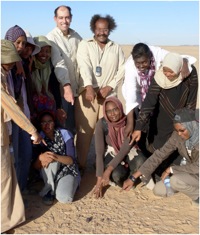 And so this object links one particular type to F-Class asteroids. In this case we could go a step further because the F-Class asteroids are very rare - 1.5 percent of all measured asteroids, and we discovered the orbit was elongated with the furthest point in the Asteroid Belt and the nearest point in Earth orbit. It is the Earth’s perturbations that tends to evolve the orbit and in the past this orbit was even more elongated, and we found one other asteroid that is even more elongated and that is 1998 K2. And so both asteroids could be from the same debris field. In other words, if we find a few more of these F-type asteroids it may take us back to the exact place in the Asteroid Belt where these come from. That’s really neat, and it was only possible to do because the orbit was so well determined. We saw this thing come in, the orbit was 10,000 times better than the typical orbit we get from a fireball because a fireball alone is only observed for a few seconds and this was observed for 20 hours. And so this object links one particular type to F-Class asteroids. In this case we could go a step further because the F-Class asteroids are very rare - 1.5 percent of all measured asteroids, and we discovered the orbit was elongated with the furthest point in the Asteroid Belt and the nearest point in Earth orbit. It is the Earth’s perturbations that tends to evolve the orbit and in the past this orbit was even more elongated, and we found one other asteroid that is even more elongated and that is 1998 K2. And so both asteroids could be from the same debris field. In other words, if we find a few more of these F-type asteroids it may take us back to the exact place in the Asteroid Belt where these come from. That’s really neat, and it was only possible to do because the orbit was so well determined. We saw this thing come in, the orbit was 10,000 times better than the typical orbit we get from a fireball because a fireball alone is only observed for a few seconds and this was observed for 20 hours.
How will surveys of asteroids continue in the future?
The focus of asteroid surveys in the past has been on large asteroids one kilometre wide or bigger, because those are the ones that can make global problems. So the goal was to find those to make sure none was coming closer, but now the effort is shifting to smaller 120 metre wide and above asteroids. These could cause local catastrophes like the Tunguska explosion. To get to smaller objects more efficiently large survey projects are being constructed, such as Pan-STARRS, which is operated out of Hawaii. Now we’ve made this link between this anomalous polymict ureilite and F-class asteroid it would be really nice if we could make more of these connections.
Read the full story of Asteroid 2008 TC3 in the June issue of Astronomy Now, onsale 21 May.
|
 |
 |
 |
|
|



